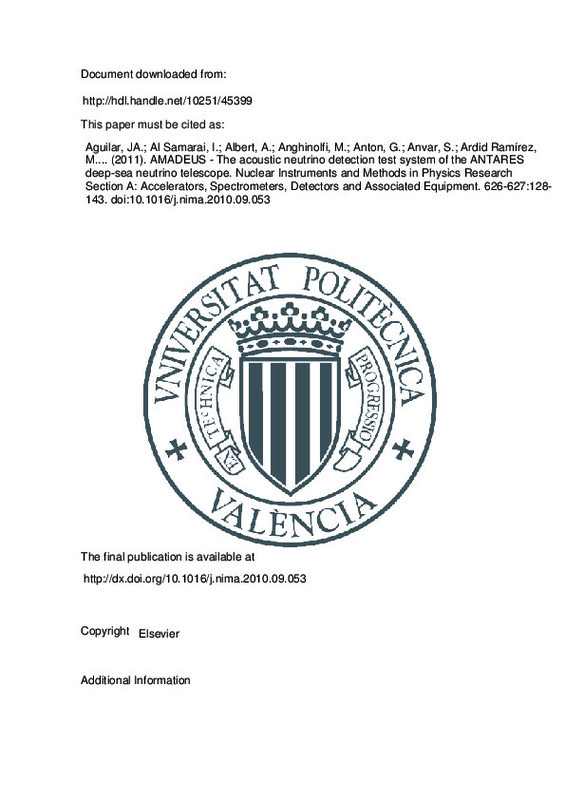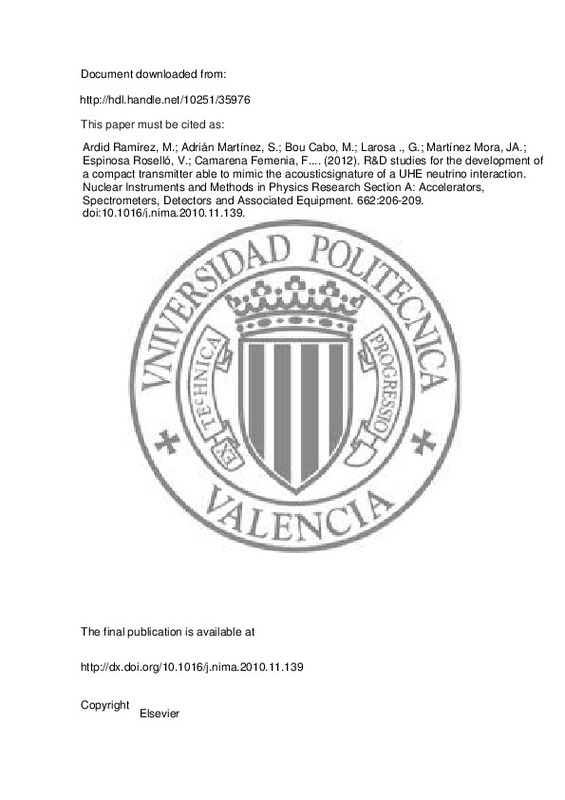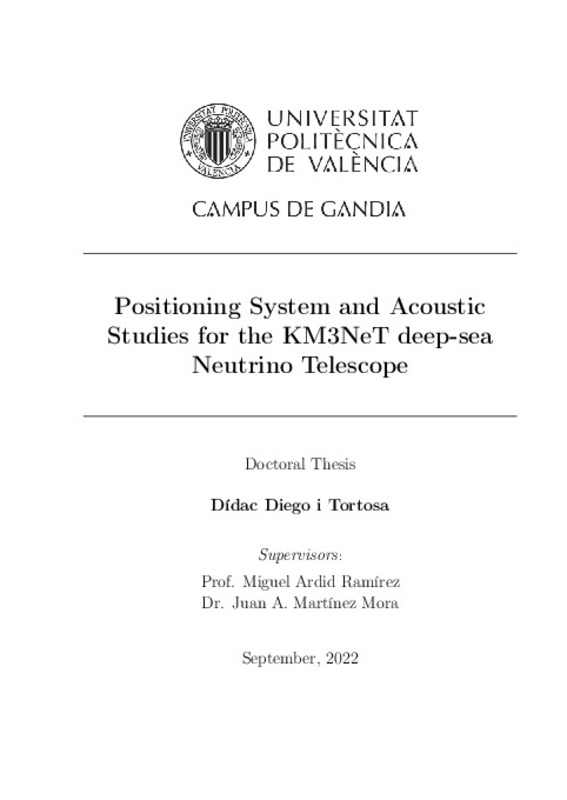JavaScript is disabled for your browser. Some features of this site may not work without it.
Buscar en RiuNet
Listar
Mi cuenta
Estadísticas
Ayuda RiuNet
Admin. UPV
AMADEUS - The acoustic neutrino detection test system of the ANTARES deep-sea neutrino telescope
Mostrar el registro sencillo del ítem
Ficheros en el ítem
| dc.contributor.author | Aguilar, J. A.
|
es_ES |
| dc.contributor.author | Al Samarai, I.
|
es_ES |
| dc.contributor.author | Albert, A.
|
es_ES |
| dc.contributor.author | Anghinolfi, M.
|
es_ES |
| dc.contributor.author | Anton, G.
|
es_ES |
| dc.contributor.author | Anvar, S.
|
es_ES |
| dc.contributor.author | Ardid Ramírez, Miguel
|
es_ES |
| dc.contributor.author | Jesus, A. C. Assis
|
es_ES |
| dc.contributor.author | Astraatmadja, T.
|
es_ES |
| dc.contributor.author | Aubert, J. -J.
|
es_ES |
| dc.contributor.author | Auer, R.
|
es_ES |
| dc.contributor.author | Bou Cabo, Manuel
|
es_ES |
| dc.contributor.author | Camarena Femenia, Francisco
|
es_ES |
| dc.contributor.author | Larosa, Giuseppina
|
es_ES |
| dc.contributor.author | Martínez Mora, Juan Antonio
|
|
| dc.date.accessioned | 2014-12-12T14:25:57Z | |
| dc.date.available | 2014-12-12T14:25:57Z | |
| dc.date.issued | 2011-01-11 | |
| dc.identifier.issn | 0168-9002 | |
| dc.identifier.uri | http://hdl.handle.net/10251/45399 | |
| dc.description.abstract | The AMADEUS (ANTARES Modules for the Acoustic Detection Under the Sea) system which is described in this article aims at the investigation of techniques for acoustic detection of neutrinos in the deep sea. It is integrated into the ANTARES neutrino telescope in the Mediterranean Sea. Its acoustic sensors, installed at water depths between 2050 and 2300 m, employ piezo-electric elements for the broad-band recording of signals with frequencies ranging up to 125 kHz. The typical sensitivity of the sensors is around - 145 dB re 1 V/mu Pa (including preamplifier). Completed in May 2008, AMADEUS consists of six "acoustic clusters", each comprising six acoustic sensors that are arranged at distances of roughly 1 m from each other. Two vertical mechanical structures (so-called lines) of the ANTARES detector host three acoustic clusters each. Spacings between the clusters range from 14.5 to 340 m. Each cluster contains custom-designed electronics boards to amplify and digitise the acoustic signals from the sensors. An on-shore computer cluster is used to process and filter the data stream and store the selected events. The daily volume of recorded data is about 10 GB. The system is operating continuously and automatically, requiring only little human intervention. AMADEUS allows for extensive studies of both transient signals and ambient noise in the deep sea, as well as signal correlations on several length scales and localisation of acoustic point sources. Thus the system is excellently suited to assess the background conditions for the measurement of the bipolar pulses expected to originate from neutrino interactions. (C) 2010 Elsevier B.V. All rights reserved. | es_ES |
| dc.description.sponsorship | The authors acknowledge the financial support of the funding agencies: Centre National de la Recherche Scientifique (CNRS), Commissariat a l'energie atomique et aux energies alternatives (CEA), Agence National de la Recherche (ANR), Commission Europeenne (FEDER fund and Marie Curie Program), Region Alsace (contrat CPER), Region Provence-Alpes-Cote d'Azur, Departement du Var and Ville de La Seyne-sur-Mer, France; Bundesministerium fur Bildung und Forschung (BMBF), Germany; Istituto Nazionale di Fisica Nucleare (INFN), Italy; Stichting voor Fundamenteel Onderzoek der Materie (FOM), Nederlandse organisatie voor Wetenschappelijk Onderzoek (NWO), the Netherlands; Council of the President of the Russian Federation for young scientists and leading scientific schools supporting grants, Russia; National Authority for Scientific Research (ANCS), Romania; Ministerio de Ciencia e Innovacion (MICINN), Prometeo of Generalitat Valenciana (GVA) and MULTI-DARK, Spain. We also acknowledge the technical support of Ifremer, AIM and Foselev Marine for the sea operation and the CC-IN2P3 for the computing facilities. | en_EN |
| dc.language | Inglés | es_ES |
| dc.publisher | Elsevier | es_ES |
| dc.relation.ispartof | Nuclear Instruments and Methods in Physics Research Section A: Accelerators, Spectrometers, Detectors and Associated Equipment | es_ES |
| dc.rights | Reconocimiento - No comercial - Sin obra derivada (by-nc-nd) | es_ES |
| dc.subject | Acoustic neutrino detection | es_ES |
| dc.subject | AMADEUS | es_ES |
| dc.subject | ANTARES | es_ES |
| dc.subject | Neutrino telescope | es_ES |
| dc.subject | Thermo-acoustic model | es_ES |
| dc.subject | Neutrino detection | es_ES |
| dc.subject | Neutrino telescopes | es_ES |
| dc.subject | Acoustic devices | es_ES |
| dc.subject | Acoustic variables measurement | es_ES |
| dc.subject | Acoustic waves | es_ES |
| dc.subject | Computer hardware description languages | es_ES |
| dc.subject | Elementary particles | es_ES |
| dc.subject | Optical telescopes | es_ES |
| dc.subject | Signal detection | es_ES |
| dc.subject | Sensors | es_ES |
| dc.subject.classification | FISICA APLICADA | es_ES |
| dc.title | AMADEUS - The acoustic neutrino detection test system of the ANTARES deep-sea neutrino telescope | es_ES |
| dc.type | Artículo | es_ES |
| dc.identifier.doi | 10.1016/j.nima.2010.09.053 | |
| dc.relation.projectID | info:eu-repo/grantAgreement/MICINN//CSD2008-00063/ES/Multimessenger Approach for Dark Matter Detection/ | es_ES |
| dc.rights.accessRights | Abierto | es_ES |
| dc.contributor.affiliation | Universitat Politècnica de València. Departamento de Física Aplicada - Departament de Física Aplicada | es_ES |
| dc.contributor.affiliation | Universitat Politècnica de València. Instituto de Investigación para la Gestión Integral de Zonas Costeras - Institut d'Investigació per a la Gestió Integral de Zones Costaneres | es_ES |
| dc.description.bibliographicCitation | Aguilar, JA.; Al Samarai, I.; Albert, A.; Anghinolfi, M.; Anton, G.; Anvar, S.; Ardid Ramírez, M.... (2011). AMADEUS - The acoustic neutrino detection test system of the ANTARES deep-sea neutrino telescope. Nuclear Instruments and Methods in Physics Research Section A: Accelerators, Spectrometers, Detectors and Associated Equipment. 626-627:128-143. https://doi.org/10.1016/j.nima.2010.09.053 | es_ES |
| dc.description.accrualMethod | S | es_ES |
| dc.relation.publisherversion | http://dx.doi.org/10.1016/j.nima.2010.09.053 | es_ES |
| dc.description.upvformatpinicio | 128 | es_ES |
| dc.description.upvformatpfin | 143 | es_ES |
| dc.type.version | info:eu-repo/semantics/publishedVersion | es_ES |
| dc.description.volume | 626-627 | es_ES |
| dc.relation.senia | 211312 | |
| dc.contributor.funder | Conseil Régional d'Alsace | es_ES |
| dc.contributor.funder | Ministerio de Ciencia e Innovación | es_ES |
| dc.contributor.funder | Conseil Régional Provence-Alpes-Côte d'Azur | es_ES |
| dc.contributor.funder | Agence Nationale de la Recherche, Francia | es_ES |
| dc.contributor.funder | Bundesministerium für Bildung und Forschung, Alemania | es_ES |
| dc.contributor.funder | Centre National de la Recherche Scientifique, Francia | es_ES |
| dc.contributor.funder | Foundation for Fundamental Research on Matter, Holanda | es_ES |
| dc.contributor.funder | National Authority for Scientific Research, Rumanía | es_ES |
| dc.contributor.funder | Département du Var and Ville de La Seyne-sur-Mer | es_ES |
| dc.contributor.funder | Generalitat Valenciana | es_ES |
| dc.contributor.funder | Council on grants of the President of the Russian Federation | es_ES |
| dc.contributor.funder | Instituto Nazionale di Fisica Nucleare | es_ES |
| dc.contributor.funder | European Commission | es_ES |
| dc.contributor.funder | Netherlands Organization for Scientific Research | es_ES |
| dc.contributor.funder | Commissariat à l'Énergie Atomique et aux Énergies Alternatives, Francia | es_ES |







![[Cerrado]](/themes/UPV/images/candado.png)



